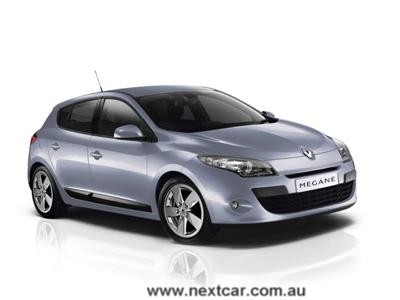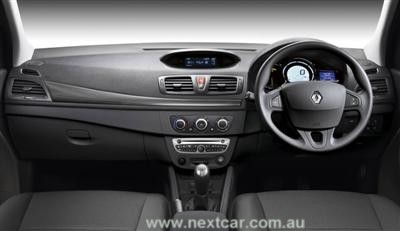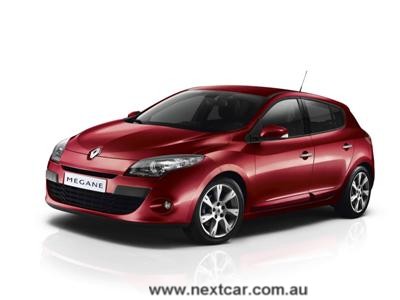New Renault Megane hatch released
|
 Renault Megane Dynamique hatch
Renault Megane Dynamique hatch
 Renault Megane Dynamique hatch
Renault Megane Dynamique hatch
 Renault Megane Privelege hatch
Renault Megane Privelege hatch
|
|
|
Home >
News >
Renault
22nd October, 2010
The newly released Megane hatch takes Renault directly into
the heart of the fiercely competitive European mainstream in Australia, and this time the Megane is well
equipped on all fronts for a successful fight with its well-established rivals.
The modern, visually striking and appealing exterior design of the new Mégane hatch changes the
perception of the Mégane range after the previous generation with its bustle back and sharp edges.
The new Renault Megane hatch fully meets customer expectations: It is attractive, made from high
quality materials, well equipped and finished to a premium standard, yet it remains eminently affordable.
It will provide a very characterful alternative to a market that at times appears somewhat monochromatic.
Priced from $25,990 drive away, the new generation Megane hatch launches right into the heart of the
mainstream, but delivers European styling and finesse in addition to its long list of standard safety and
convenience features.
Two models will be offered in Australia.
The manual transmission Dynamique model uses a Euro 5-compliant 102 kW 2.0-litre, 16-valve
four-cylinder engine.
The Dynamique and top-of-the-range Privilege grade models equipped with a new Continuously Variable
Transmission are Euro 4-compliant and are rated at 103 kW.
Both Euro 4 and Euro 5 engines deliver identical torque of 195 Nm at 3,750 rpm, and both achieve peak
power at 6,000 rpm.
The frugal engine consumes only 7.9 litres per 100 km on the combined test cycle, when teamed with the
CVT.
The new Renault Megane hatch will also offer exceptionally good driving dynamics, safe handling with
reduced body roll, and direct, and responsive steering. These changes improve on the already effective
ride and handling of the previous model. In particular, engineers concentrated on improving still further,
steering precision and feedback.
A further area of focus was reducing body roll during corning while maintaining a compliant and
comfortable ride.
Compared with some rivals the new Renault Megane hatch will be perceived as top-of-the-class in terms
of interior presentation, quality of materials and the excellence of the fit and finish.
Manufacturer’s List Pricing for the New Renault Mégane hatch*
Renault Mégane Dynamique (manual) $22,990*
Renault Mégane Dynamique CVT (auto) $24,990*
Renault Mégane Privilege CVT (auto) $29,990*
The Dynamique manual is offered at $25,990 drive away by Renault dealers in Australia from launch.
NOTE* Unless otherwise noted, the prices indicated in this news article are the Manufacturer’s
List Price/s (MLP) which does not include on-road costs (such as dealer delivery fees and the state and
territory statutory charges). Additionally, prices, fees and charges are subject to change without
notice.
The new generation Renault Megane hatch in detail
Body Design
The new Renault Mégane hatch arrives as a distinctively modern, fresh and exciting family hatchback
that is 4,295 mm long, characterised by an unmistakably dynamic stance thanks particularly to its short
front and rear overhangs, its 2,641 mm wheelbase, its steeply-raked roofline and wide front and rear
tracks; 28 mm and 33 mm wider than its predecessor.
Its assertive 'personality' is immediately apparent through its sporty front-fascia, featuring sharp,
contemporary crease lines that sweep down from the windscreen pillars and across the bonnet.
The streamlined forms of the headlights extend the fluid contours of the air intakes to reinforce
front fascia’s determined expression and piercing gaze.
The strong character of the new Renault Mégane hatch is also apparent at the rear where the two-piece
light clusters not only continue the feature line but also facilitate easy access to the boot. The Latin
influence of the car’s elegantly sensual curves is especially visible when viewed in profile.
The new Mégane hatch immediately exudes an impression of robustness and quality. Seen from the side,
the feature line extends rearward from the slightly prominent front guards to emphasise the car’s solid
'shoulders'. The front and rear tracks ensure the new Mégane hatch sits squarely on the road. The
proportion, form of the waistline and large doors express a feeling of protection. Coupled with the
generous proportions of the bodywork, a blend of flowing lines also optimises the visual effect produced
by the light reflecting off the body.
Particular attention has been paid to reducing the shut lines between the different body panels (e.g.
windscreen pillars, fuel filler flap) and the front and rear bumpers, which discreetly incorporate the
parking proximity sensors.
The new Renault Mégane hatch’s roofline also benefits from specific treatment thanks to the use of
laser brazing which eliminates the need for roof trimming.
Special attention has been also paid to acoustic comfort. The design and sealing quality of the
doors and tailgate, the fitment of inserts inside the hollow sections of body components, one-piece cowl
sound proofing and foam dashboard structure all contribute to minimising the transmission of noise into
the cabin.
Interior
The interior presents a driving environment based on fluid, uncluttered forms.
Great care has also gone into the quality and fit-and-finish of the materials employed, at all
equipment levels. The dashboard benefits from a finish that is not only soft to the touch, but also
resistant to the ageing effects of sunlight.
The windscreen wipers are aesthetically concealed beneath the bonnet line, a choice that favours
acoustic and aerodynamic performance.
One particular Renault innovation is the cruise control/speed limiter which comes with a new
interface. When this function is activated, the speed selected by the driver is displayed at the top of
the speedometer which itself is ringed by a sequence of lights that take the form of an arc around the
central display. In speed limiter mode, the red segment lights up as the speed increases, while the
selected speed flashes if exceeded. The use of colours is not only intuitive and functional; it also
represents a gain in terms of response time.
The new Mégane hatch also comes with a height-and reach-adjustable steering wheel (reach adjustable
by up to 45 mm).
Special care has been taken with the position of the pedals; the brake pedal has been offset by an
additional 10 mm from the accelerator pedal. It is also 30 mm wider to facilitate movement of the right
foot from one to the other when braking.
Practical storage solutions are a Mégane strength and the new car does not disappoint. It continues
the unique and user-friendly under-floor storage solutions from the previous generation car, while the
front door bins can hold a one-litre bottle. The centre console stowage incorporates space underneath
the armrest and rear passengers can profit from an open, practical, easily accessible cubby.
The new Renault Mégane hatch also stands out by the amount of luggage it can hold. The hatchback’s
boot volume of 360-litres is among the best in its class.
CVT transmission
CVT (Continuously Variable Transmission) does away with conventional gear changes to provide smooth,
seamless performance for a free-flowing driving style and returns impressive fuel economy.
In the case of a conventional automatic transmission, the ability to adapt the point on the engine's
operating curve to the demand for power is restricted by the number of available gears. The continuous
variation of the CVT allows the point on the engine's operating curve to be optimised, even during
transient phases, the aim being to provide continuous variation of several gear ratios by
simultaneously adjusting the diameter of the primary and secondary pulleys, which are linked by a
steel belt.
CVT consequently permits continual variation of a number of ratios in order to optimise the point on
the engine's operating curve (engine speed and throttle) from the fuel consumption, emissions and
acoustic comfort points of view.
Thanks to the work of the Alliance's engineers, Renault's CVT figures among the best in its class
with regard to its seamless acceleration performance.
Chassis
The new Renault Mégane hatch features front struts with rectangular lower arms and a 22 mm-diameter
anti-roll bar, while the rear incorporates a programmed-deflection flexible beam.
The combination of springs calibrated at 19.5 mm/100DaN at the front and 20.2 mm/100DaN at the rear
specific damping calibration for the rear has enhanced the vertical suspension performance and reduced
body roll.
The Mégane’s specific roll angle, which defines body lean as it corners, is rated at 0.42° for
lateral acceleration of 1m/s2. The European segment average is 0.45°.
The new Renault Mégane hatch also benefits from a particularly effective braking system, with large
discs that provide outstanding stopping power and durability, as well as an extra degree of safety for
occupants. Thanks to 280 mm-diameter vented front discs and 260 mm rear discs, The Mégane hatch can
come to a stop from 100 km/h in 39 metres.
The new Renault Mégane hatch has electric power steering that combines precise driver feedback with
swift, accurate response to instructions from the wheel. It is easy to use and feels completely
natural. The technology employed and the calibration of the control unit ensures both steering
precision and genuine driving enjoyment. The improvements cover the fitment of an inductive torque
sensor (0.6ms), which is four times quicker than an optical sensor, increased steering control unit
sampling frequency (1000Hz, compared with 420Hz in the case of the previous generation model).
A broader dynamic servo motor bandwidth (300Hz, compared with 70Hz in the case of Mégane II).
Safety
The new Renault Mégane hatch features a long list of features aimed at helping drivers avoid risky
situations, such as automatic headlight and windscreen wiper activation and a cruise control/speed
limiter. Standard active safety features include ESP, ABS, EBD and emergency braking assist.
High levels of passive safety are provided by the programmed deformation of the structure. The
structure is comprised of high, very high and very, very high elastic limit steels, selected to absorb
and dissipate as much kinetic energy as possible.
Controlled deformation ensures that occupants are subjected to lower deceleration forces and this,
coupled with the Renault System for Restraint and Protection, guarantees an extremely high level of
protection.
The Renault System for Restraint and Protection takes into account both impact force and the build
of occupants. It comprises simple Pretensioners (which tighten the seatbelt against thorax to restrict
forward movement of the body), load limiters (which reduce the pressure applied by the belt to the
thorax) and front airbags (which deploy by just the right amount to absorb impact energy).
The package also optimises protection against the phenomenon known as submarining, which can often
produce serious abdominal lesions in a collision.
The front of the new Renault Mégane hatch has also benefited from work aimed at improving
pedestrian impact protection. The rigidity and thickness of the bumper have been modified to protect
the lower limbs by absorbing energy at tibia and knee height. Careful attention was also paid to the
energy absorption capacity of the bonnet and surrounding structure (guards, opening mechanism and
bonnet lining).
Equipment
In addition to its striking visual presentation, the new Renault Mégane hatch is exceptionally
well equipped at this price point. The range includes a wide array of surprise and delight features
for customers, including some not otherwise available in the small car class.
These include the unique hands-free Renault smart card key, integrated satellite navigation system
(that is both affordable and efficient and equipped with a remote control command module), Bluetooth®
connectivity, multimedia connection box (Aux. input socket and USB support), and 3D sound “Arkamys®”
Stereo with CD/MP3 compatible and high quality sound.
The hands-free Renault Smart Card allows entry and engine ignition. The car also remotely locks
the car as the driver walks away. The doors can also be locked automatically by pressing the button
on the driver’s door handle.
The doors unlock when the hand of the person carrying the card hovers over one of the door handles
or activates the boot latch.
A handy remote lighting function enables drivers to locate their vehicle thanks to a specific
button on the card, which switches on the lights as the approach.
Connectivity takes pride of place on the new Renault Mégane hatch thanks to the standard RCA
socket located on the centre console, which enables occupants to enjoy personal music collections
stored on portable players.
All models feature the multimedia connection box which enables the driver to scroll through the
functions of portable players (USB key, iPod®, etc.) using the car's own steering wheel-mounted
finger-tip remote controls, with menus plus play lists shown remotely on the dashboard display.
|
|
|

Self-Catering Holiday
Accommodation in
Denmark, WA
..... more
|
|
|
Standard on Mégane Privilege and optional on Dynamique hatch is an integrated satellite navigation
system, complete with joystick controller, while all models have Bluetooth® hands-free telephone
controls.
The joystick control is located in the middle of the centre console and is exceptionally intuitive
and easy to learn.
New for the Renault Mégane hatch, the menu can be customised as a function of the driver's
preferences to activate, deactivate or adjust the parameters that govern certain functions,
including the language employed and even the activation of the automatic headlamp sensor.
A further notable interior feature is the attractive dashboard with a large clear easy to read
digital speedo display, a feature sure to be appreciated by city drivers in this age of unforgiving
speed cameras.
Three well-equipped models will be available from launch all of which share a 2.0-litre engine,
matched to a choice of six-speed manual or Continuously Variable Transmission (Dynamique models).
The Privilege is available only with the CVT.
The Dynamique manual is priced at $22,990* (Manufacturer’s List Price*) or $25,990 drive away,
while the same engine and specification is also available matched to a Continuously Variable
Transmission for $24,990* (Manufacturer’s List Price*).
The top-of-the-range Privilege model uses the same engine and CVT transmission, but adds more
luxuries such as leather upholstery and has a Manufacturer’s List Price* of $29,990*.
Standard features for the Dynamique models include Electronic Stability Programme, ABS with EBD
and emergency braking assist, 6-airbags, automatic headlamps and windscreen wipers, cruise control
with speed limiter, fog lights, hands-free Renault key card, dark charcoal upholstery, height
adjustable driver’s seat with lumbar support, manual climate control air conditioning, Bluetooth
connectivity, four-speaker AM/FM stereo with two tweeters and CD player/MP3 player and steering-wheel
controls, digital speedometer, AUX-input, electric windows, body colour door mirrors with heater
element, body colour door handles, 16-inch ‘Proteus’ alloy wheels and a 60/40 split fold rear seat.
The top-of-the-range Privilege model adds an electric sunroof, rear parking sensors, black leather
trimmed upholstery, height and lumbar adjust for driver and passenger front seats, leather wrapped
steering wheel, dual zone climate control, integrated satellite navigation system, four (more
powerful) speaker AM/FM stereo with 3D sound and four tweeters, CD/MP3 player, rear central console
with cup holder and rear air vents, chrome door handles, body coloured, heated and folding door
mirrors and 17-inch ‘Monitor’ alloy wheels.
The climate control air conditioning allows occupants to select the fan speed using the
Soft-Auto-Fast function. In ‘Auto’ mode, the system automatically optimises the temperature, sound
level and start-up speed. The ‘Soft’ mode favours a quieter ambience, notably for the driver and
front passenger, while the ‘Fast’ mode responds swiftly and efficiently to adjust the temperature
of the entire cabin, a feature likely to be appreciated in Australia when cars parked in the sun
heat up fast and need to be cooled down quickly when drivers return.
Optional equipment for the Dynamique model is limited to metallic paint and Integrated Satellite
Navigation, while the Privilege offers bi-Xenon headlamps and metallic paint.
Environment
The socially responsible new Renault Mégane hatch is 95% end-of-life recoverable by weight,
while almost 12% of the plastic it employs (an average 22 kg) is sourced from recycling.
On sale dates
The new Renault Megane hatch is on sale now at Renault dealers around Australia.
|